People
The Brooklyn Museum’s Anne Pasternak on Why ‘Protest Is Here to Stay,’ and How Data (and David Bowie) Show the Way Forward
The oft-embattled Brooklyn Museum director spoke to artnet News's Andrew Goldstein about her friction with the left.
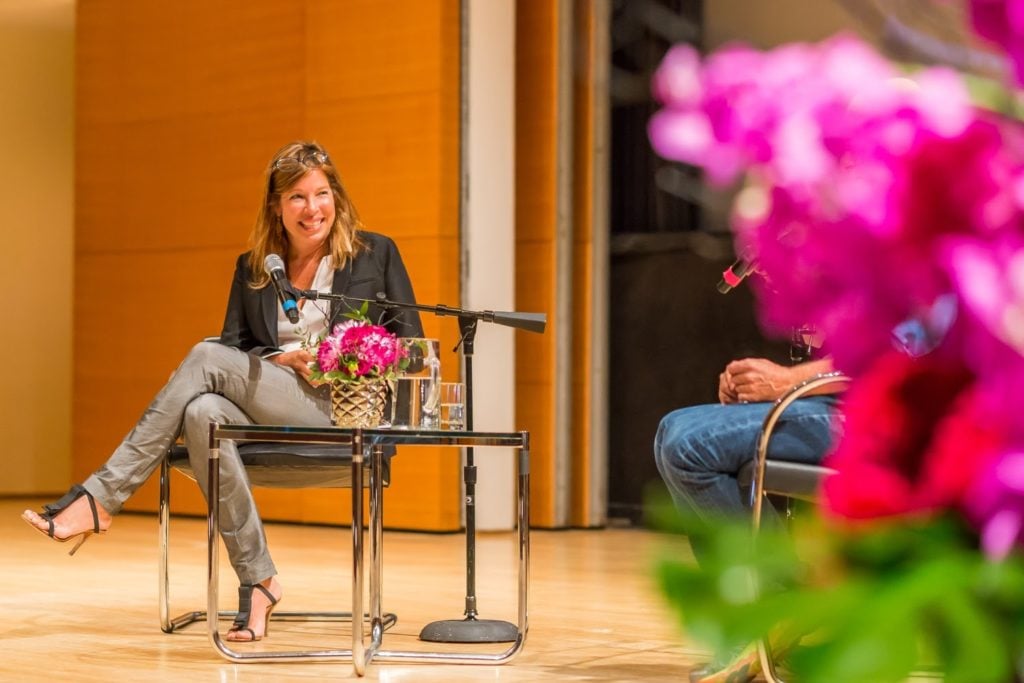
The oft-embattled Brooklyn Museum director spoke to artnet News's Andrew Goldstein about her friction with the left.

Andrew Goldstein

Just last Friday, activists from a protest group called Decolonize This Place marched into the halls of the Brooklyn Museum bearing colorful signs and banners to call attention to the provenance of certain artworks in the museum’s acclaimed Egyptian art wing and other collections. “How was this acquired? By whom? For whom? At whose cost?” read one banner, which was photographed and pinged around social media.
Symptomatic of a broader movement to redress the historical wrongs of colonialism, the group—which takes its name from an earlier 2016 protest of another Brooklyn Museum show, “This Place,” that set out to explore the “complexity of Israel and the West Bank” but received money from pro-occupation funders—has proven to be an unremitting gadfly on the flank of the institution. Its sting has also been keenly felt by the museum’s director, Anne Pasternak, a liberal-minded administrator who is doing her level best to find a workable middle ground between the exigencies of running a cash-strapped repository of the world’s accumulated (some might say displaced) culture, and the revolutionary ideals of a restive, empowered, and increasingly vocal left.
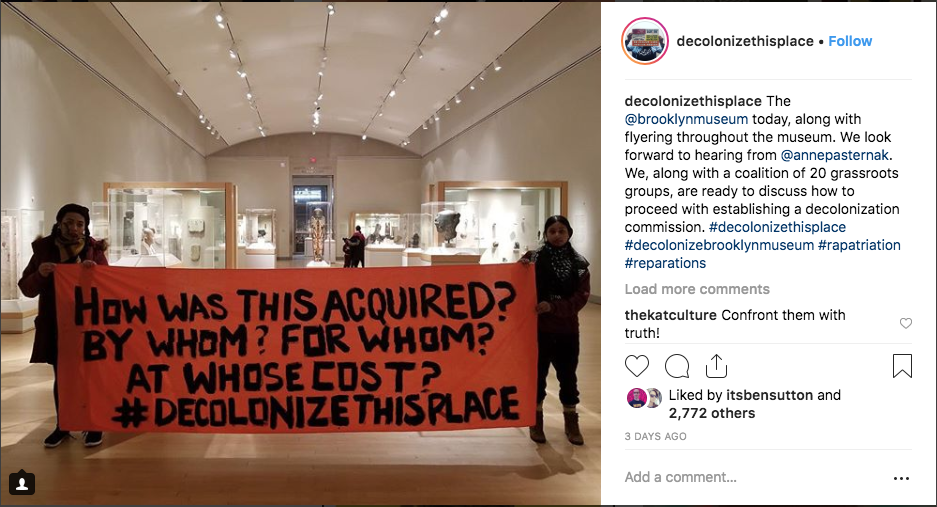
An Instagram post by #decolonizethisplace from the group’s Friday, November 30th, protest.
In the conclusion of a two-part interview, artnet News’s Andrew Goldstein spoke to Pasternak about the protests around her exceedingly progressive museum—which, in an earlier cultural moment, had become accustomed to being the perennial target of the right (c.f., Rudy Giuliani vs. “Sensation”)—and why she views David Bowie, data, and collection-sharing as offering the path forward to a more sustainable future.
I often think about how people in the art community always talk about “the art world,” as if it’s a community that has a certain kind of shared value system that is somehow different from, and maybe even oppositional to, the world at large. In this time where we’re seeing a tilt towards extremism in the culture at large, if there’s anyplace that could be a laboratory for creating the kinds of relationships and communities that we’d like to see in the world, maybe it’s the art world. As museum directors, as gallery proprietors, people in these positions have power over how they want to shape their community. It’s a big responsibility.
I think that the traditional role of a museum as a temple for art and a place of refuge is so beautiful and so important and so powerful. And I think we can be more, and I think that we must be more. We need to contribute to the diverse cultural vitality of our communities. We need to engage in the difficult conversations, not retreat from them. We need to be places of questioning and debate—not safe spaces—as we try as a society to plan for a greater future. Where else can you go today to have these kinds of conversations? College campuses? Well, then you have to be in college. Religious spaces? Maybe. There just aren’t that many public spaces for these kinds of things today—so I think the role of the museum is critically important.
Ironically, as you have been working to integrate a culturally diverse approach in the museum, the fiercest criticism of the institution has come from the left, with some accusing the museum of falling short of its ideals. For one thing, there was the highly publicized protest of the museum’s decision to hire a white curator, Kristen Windmuller-Luna, to head up the African Art department. How can you reconcile that?
By the way, I’ve been protested by the right, too, but it’s true that it’s mostly coming from the left. One writer called me the enemy of civilization, and they’ve called David [Berliner, the president and COO of the Brooklyn Museum] the coming of the apocalypse. One of these was coming from the left, and the other from the right. [Laughs]
But, listen—in terms of the protests, these are very painful times. Everything has become very divisive, and protest is here to stay. Central Brooklyn in particular is ground zero, or one of the many ground zeroes, for the social discontents of our time.
The artist Hank Willis Thomas said to me, “Anne, you have to learn to lean into controversy.” Easier said than done, but I think there’s truth to that. So, on the one hand, I will be frank and say that a lot of these controversies are based on untruths, and I am pained by the toxicity of some of the rage and arguments. But, on the other hand, they’re also based in something that’s very true. And in the case of hiring our African art curator, the ultimate, fundamental point was that there has not been enough diversity in art institutions, and that people’s histories have been either ignored or they’ve been wrongly framed or they’ve been spoken down to. I could not agree more with the critique about the need for institutions, including ours, to have greater diversity. So what one tries to do is step above and say, “OK, what can we learn from this? How can we contribute to only making changes within the institution but also within the field to address a very real issue.”
So we tried to do that internally. We have a very diverse staff, with many people coming from the community, and we have a reasonably diverse board, but all at all levels there’s room for growth. That’s why we have diverse staff committees who work on major curatorial appointments, including Kristen’s appointment. We have a task force looking at how we’re hiring people, to see what we can do better. We’ve created a task force around issues of colonization, which is very different for our institution than, let’s say, the British Museum, but is nevertheless an important conversation. We have been working ever since I got to the museum to create a paid internship program, and we had nearly 70 paid interns this summer, some of whom were teens, some of whom were college students, some of whom were kids in foster care.
Finally, we found a donor—Citi, in this case—that came in and supported our working with young fellows from historically black colleges and universities around the nation, as well as the CUNY system. We’re doing many things to try to find opportunity for people who have not normally found a place in an institution like ours.
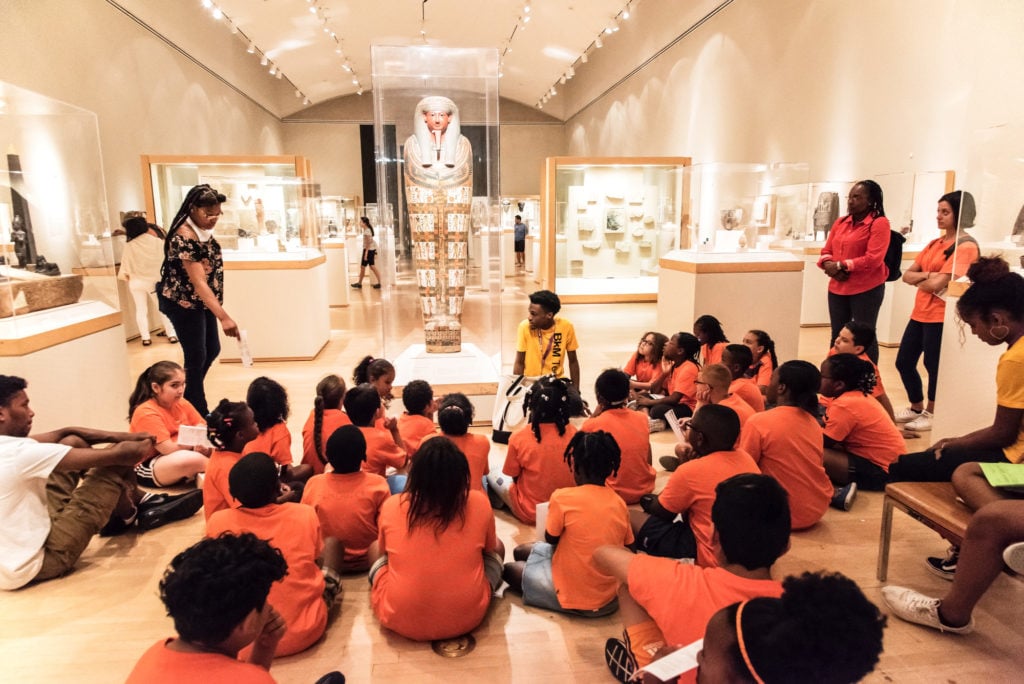
An education tour through the Brooklyn Museum’s Egyptian galleries. Photo by Emma Buhain, courtesy of the Brooklyn Museum.
Can you tie that back to the hiring of a white African art curator? When your hire was criticized you responded strongly, saying “to state unequivocally” the Brooklyn Museum “stands by our appointment…. With her anticolonial approach to curating, [Windmuller-Luna] has devoted her professional life to celebrating the individual identities of historical African cultures.” Is there any way that you regret hiring her?
Every day that I get to work with Kristen, I’m more and more convinced that she was a brilliant hire. And I am very optimistic that when our audiences see her work, they will be wowed. You know, one of the great critiques of institutions like ours is that, considering this material is not that old—it’s made from natural materials, and some of it’s just 50 or 100 years old—why don’t we know who the makers of these works are? Well, Kristen agrees with that critique. She’s working on an exhibition around an Egungun mask that we have, and she went off to Nigeria to see if she could find the family of the person who originally created the mask—and she did.
At the same time, we have to do more as a field to help people of all backgrounds pursue higher degrees in these areas, because there just aren’t that many. Some people ask, well, then, why do you need a PhD? But we’re talking about more than 50 countries in a continent, and millennia of history—of course you need a PhD-level specialist. And there are very few PhDs in African art history in this country each year, something on average one or two, and even fewer of them are people of color. Initially, of course we went out to try to find somebody of African heritage, but many of them who do exist have incredibly prominent jobs already, like at Princeton, and they’re not coming to work at the Brooklyn Museum.
So, I think the misinformation out there has created tremendous damage. I was so grateful for the dozen or so phone calls we got from community members saying, “I love the Brooklyn Museum—pease help me understand the decision that you made.” It was an opportunity for conversation. I’ll tell you we also had elected officials who called us up, screaming at us, who were not willing to have a conversation. And I’ll tell you there are plenty people in the community who are so hurt, so angry, and I’m reaching out to them. Repairing those relationships is extremely important.
Another perennial source of friction has been the museum’s sources of funding. First there was the protest that the museum rented out space to a real-estate industry convention where gentrification was championed, then there was the protest of the show “This Place” for being backed by pro-Israel funders who actively support the occupation, a protest that gained significant traction. What does it mean that these left-wing attacks so often target the museum’s funding sources, given that the museum’s finances have long perilously been on a shoestring? It reminds me that, when I asked him about museum funding, the new Met director Max Hollein said museums need to “have a morally sublime attitude” when it comes to fundraising.
But what does that mean? What would a morally immaculate funding source be? One that agrees with your politics? First of all, let me just say that all nonprofit or educational institutions are facing the same question: are we doing more good or harm by taking funding? And you have to look at that on a case-by-case basis. I would love to talk to Max about what a morally sublime funding source would be. I mean, we take government funding—need I say more? Every funding source has its complexities. At the end of the day, I’ll say it again: we may have one of the biggest buildings and one of the biggest collections of any encyclopedic museum in the country, but we have the smallest endowment, one of the smallest operating budgets, and the smallest staff. So when these controversies happen it just makes our job that much harder. It’s damaging to the institution.
Recently, in the aftermath of the murder of Washington Post journalist Jamal Khashoggi at the hands of the Saudi government, the Brooklyn Museum joined the Metropolitan Museum of Art in rejecting Saudi funding for current programming, in your case the show “Syria, Then and Now,” that was part of the Arab Art & Education Initiative. How much money was at stake there?
It’s the first time in my life that I’ve ever returned funding for an exhibition. I did not do that lightly, and I’m not even a thousand percent sure that I did the right thing. The reason why I did it was because the funding from the Misk Foundation is directly Crown Prince Mohammed bin Salman’s money, and our partnership was based on an explicit agreement for the exchange of ideas to create a cultural bridge for understanding and cooperation. As it became more likely that he had direct knowledge, if not involvement, with the execution of Khashoggi, that was was a direct violation against freedom of expression. In principle, that’s non-negotiable for our institution. I felt that we needed to take a moral position, so we did. Just so you know, the Met’s funding was $20,000, and I’m returning $50,000. And I’m really proud that we did an exhibition about 100 years of refugees’ stories in Syria.
For another museum, giving up $50,000 might not seem like a lot of money, but the financial hardships at the Brooklyn Museum are plain to see. On a recent walk through the decorative art galleries, I saw visibly scuffed walls, holes pockmarking the drywall, and threadbare, rumpled carpet. As you said before, less than half of your visitors pay any of the $16 suggested admission fee. Membership is growing, but all in all this is fairly thin gruel, even when augmented by the money the museum gets from Bloomberg Philanthropies, donors, and its board. How can this revenue be increased?
Well, first I should say that every institution has some threadbare carpeting. Go to the Met and look at their Egyptian galleries and you’ll see the same thing. But when it comes to increasing revenue, first of all I think that we’re going to continue to do better and better in terms of attracting audiences as we find the right mix of exhibitions, as we expand our our marketing reach, as we expand our education programs, and as we continue to have public programs with artists and thought leaders who people are wild about. But it is true that central Brooklyn and the Brooklyn Museum feel like a destination for people who are not in these immediate zip codes, and for tourists who know to go to Museum Mile for one-stop shopping of a handful of the city’s greatest museums.
So we need to start telling the story better about why the Brooklyn Museum is a different experience than other museums in Manhattan, and Eastern Parkway really needs to start to thinking of itself more as a cultural corridor. You have the Brooklyn Botanic Garden, you have Frederick Law Olmsted’s Prospect Park, you have the library, and just down the road is the Brooklyn Children’s Museum.
That said, we know that people go to museums for special exhibitions—and those special exhibitions will drive the audience, which will drive ticket revenue, museum-shop revenue, café revenue, and all of those things that will help get us to a more stable position.
I did an interesting interview a little while ago with Charles Venable, the museum director who relaunched the struggling Indianapolis Museum of Art—which had perennially been losing visitors and was undergoing a budgetary crisis—as Newfields, a omni-cultural destination built around enjoyable social experiences. He was guided in his rebranding effort by Culture Track, a research division of the marketing firm LaPlaca Cohen that determined “fun” was the overwhelming attribute that people seek in their cultural experiences, and more traditional measures of museological excellence—like immense collection holdings and rigorous scholarship—were actually more important to the museum’s employees than to its audience. As a result, he changed his programming, cut staffs in curatorial departments that didn’t draw crowds, and has put his institution on the road to financial stability. Are there any pieties at the Brooklyn Museum that you believe might be rethought in order to better engage audiences, raise revenues, and potentially cut costs in a non-damaging way?
The answer to that is absolutely, yes. No business operates on a 100-year-old model. We have been trying, and it doesn’t work. So there are a lot of these pieties to question. For example, no longer is our greatness defined by the number of objects we have in our collection, right? It’s about how the objects in our collection perform in our galleries. So, why is it that less than 10 percent is actually on view in the museum at any given time? Why is it that we have about as many storage rooms as we do galleries? It could be argued that there’s work in our collection that would be better served in other public institutions where the work would be transformative, while it’s not transformative in our institution.
These are questions we’re asking ourselves right now. We watched what Charles was doing at Newfields very carefully, and I was very impressed by how he used a deep dive into data to create a really strong strategy. It was an issue of survival that they expanded their audience. And today there’s so much more competition for people’s time than when we were created 200 years ago.
Going back to what you said about fun, if you look at LaPlaca Cohen’s Culture Track report, 81 percent of Americans say that “fun” is the number-one reason why they go to a cultural experience or institution. The people who go to museums for art and more intellectual reasons don’t have to share that. But why should those 81 percent of people be denied an engaging, educational, mission-oriented experience with art? Why is the idea of enjoyment in the museum something to scoff at?
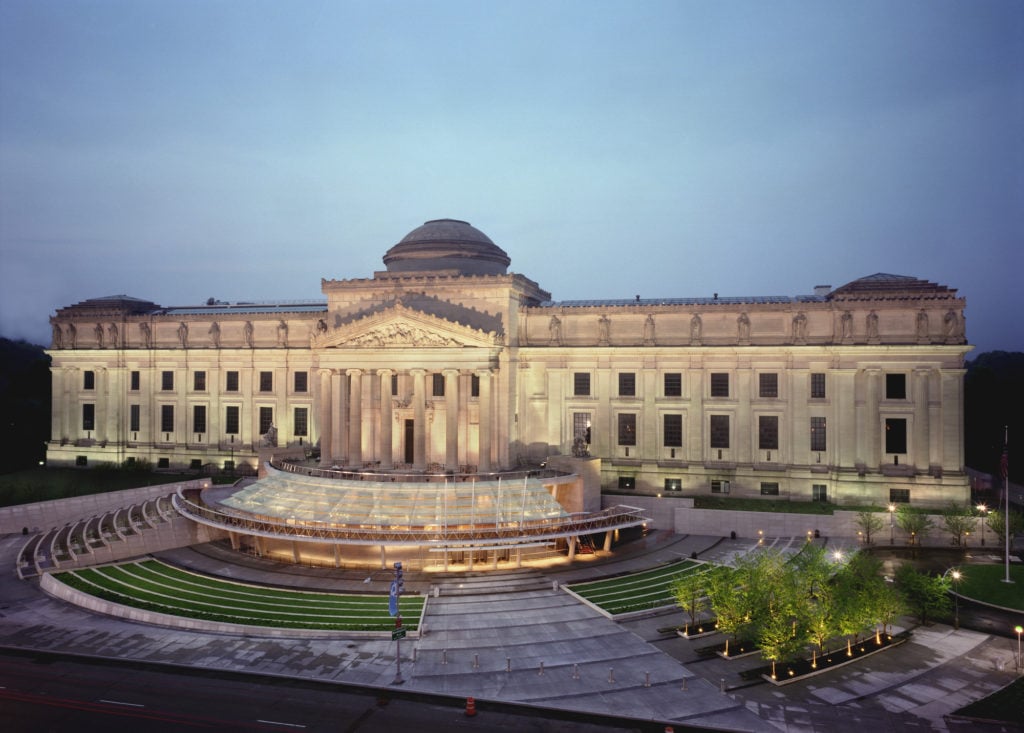
The Brooklyn Museum at dusk. Courtesy of the Brooklyn Museum.
You mentioned the idea of shifting some parts of the Brooklyn Museum’s collection to other institutions—something that is, in fact, not new. In 2008, the museum made an arrangement to donate its eminent costume collection to the Met, giving them the burdens of conservatorship while retaining the right to access the garments. Is that something along the lines of what you’re thinking now?
You know, [my predecessor[ Arnold Lehman is a trailblazer, and that partnership with the Met was criticized by many. I actually suspect that collection-sharing will be something that institutions think much more proactively about in the future, rather than competing with one another for the same objects. Why don’t we just share? As much as I’d like to have that costume collection here and look at it every single day, I think it was a very wise decision.
Are there any areas of the museum’s holdings in particular that you think would benefit from collection-sharing?
Not right now. But I think that there are other institutions we can borrow from and share with more, and it’s going to be increasingly important because the art market is so nuts that very few institutions are going to have the ability to continue purchasing work.
You mentioned that you’ve been impressed by Charles Venable’s data dive into Newfields. Have you undertaken anything similar at the Brooklyn Museum?
In fact, we’ve been working with [consulting firm] McKinsey since the end of August. They took us on as a pro bono client, and we are unbelievably grateful, because it’s been just mind-blowing to see how they operate in teams and the kind of data that they can pull together. Mike Bloomberg always says, “You can’t manage what you can’t measure,” and it’s true. We can make guesses about what people want, but if you actually ask them you’re likely going to get very different answers. What I want in the café or in the shop may not be what 98 percent of our audience wants. Data matters.
One piece of data that is pretty clear is that everybody went crazy for the David Bowie show you did this summer. The art crowd loved it, it drew over 180,000 visitors, it allowed you to try out new monetization strategies, and was the biggest blockbuster in the museum’s recent history. How do you explain that show’s success?
I think there are these paradigms within our field—like populist versus elitist, high versus low—that are very divisive, even destructive, to our institutions. In fact, I was a little concerned about taking on the David Bowie show because I know that one of the criticisms against the museum has been that we’re populist.
But the staff really wanted to do the show, and I love David Bowie, so I said to them, “Okay, let’s think about the stories we’re going to tell, and how we’re going to engage people so we’re not attacked for doing something populist just because David Bowie is a star, but doing something with real integrity about who he was as an artist.” The staff really took that to heart. And, you know, the show was brilliantly organized by the Victoria and Albert Museum in London and traveled to 10 other venues before it came to us—we were the last venue—but we expanded the exhibition to dive even deeper into some aspects of David Bowie’s story that were relevant to our audiences. People responded really well to that.
What was your angle on the David Bowie story?
There were a number of angles, but part of it was about how he was a pioneer in terms of being boundary-breaking as an artist—he was a musician, he was a dancer, he was a mime, he was a genius of costume and performance, he painted, he made collages, he made drawings. So many artists today are trying to break through the boundaries of being just one thing, so I think that was inspiring to people. He was also unbelievably courageous in terms of gender and sexual identity, and these are conversations that people are having all the time now.
So I think there were several narratives that really resonated with our audiences, and we got amazing letters of thanks. We saw people in tears in the exhibition every day, and people spent, on average, something like 96 minutes in the show—that’s a long time to be in an exhibition.
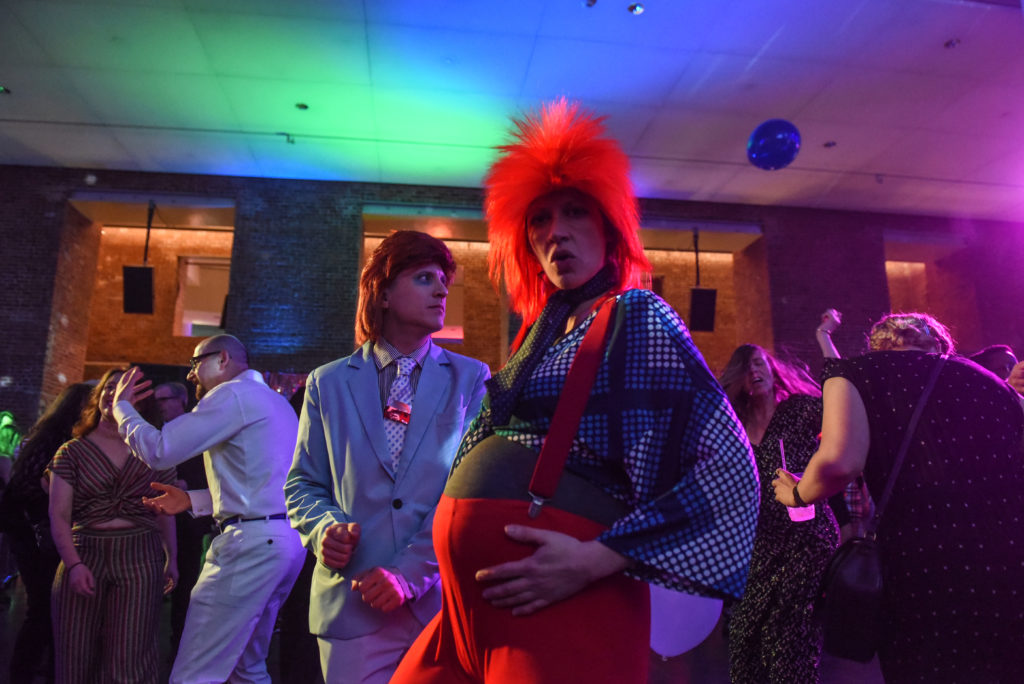
People dressed in their favorite David Bowie “look” for “A Night of 1,000 Bowies” at the Brooklyn Museum during the run of its Bowie exhibition. (Photo by Stephanie Keith/Getty Images)
What did you learn from the show?
One thing we learned was that people love an immersive experience. The sound system and the headphones were really additive to helping people connect with what they were seeing.
But more that that, we realized that, ultimately, people connect with biography, and they care about story. If you take a look at a lot of blockbusters, there’s usually a great story behind them. Look at Basquiat. Look at Frida Kahlo. The list goes on. Having a great biography is a big part of the allure, because people can relate to it. Maybe, when it comes to Frida Kahlo, they have a disability, or they have a mother with mental illness. And I don’t think that takes away from the art—I think it adds to it.
You know, young art history students today look at an artwork from a biographical point of view, from a formal point of view, and from a sociopolitical and cultural point of view. There are multiple factors that people take in to consideration when looking at art today, and I think that presents an opportunity for a museum to open up and reach people no matter what kind of a learner they are. It’s really about storytelling, both through the exhibitions and through storytelling about the museum itself.
Read part one of this interview here.